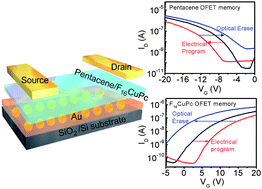Micellar poly(styrene-b-4-vinylpyridine)-nanoparticle hybrid system for non-volatile organic transistor memory†
Abstract
We present organic field-effect transistor (OFET) memories where in-situ synthesized gold (Au)

* Corresponding authors
a
School of Materials Science and Engineering, Nanyang Technological University, Singapore, Singapore
E-mail:
leon0043@ntu.edu.sg, pslee@ntu.edu.sg
b School of Electrical and Electronic Engineering, Nanyang Technological University, Singapore, Singapore
We present organic field-effect transistor (OFET) memories where in-situ synthesized gold (Au)

 Please wait while we load your content...
Something went wrong. Try again?
Please wait while we load your content...
Something went wrong. Try again?
W. L. Leong, N. Mathews, S. Mhaisalkar, Y. M. Lam, T. Chen and P. S. Lee, J. Mater. Chem., 2009, 19, 7354 DOI: 10.1039/B911493A
To request permission to reproduce material from this article, please go to the Copyright Clearance Center request page.
If you are an author contributing to an RSC publication, you do not need to request permission provided correct acknowledgement is given.
If you are the author of this article, you do not need to request permission to reproduce figures and diagrams provided correct acknowledgement is given. If you want to reproduce the whole article in a third-party publication (excluding your thesis/dissertation for which permission is not required) please go to the Copyright Clearance Center request page.
Read more about how to correctly acknowledge RSC content.
 Fetching data from CrossRef.
Fetching data from CrossRef.
This may take some time to load.
Loading related content
